The Shanghai observatory of the Chinese Academy of Sciences may be expanded to include a new astronomical observation station in Zhejiang Province that would be out of range of adverse effects caused by the bright lights of Shanghai.
The director of the Sheshan base, Tao Juan, said that the light from Shanghai has already reduced visibility there, so the observatory must seek a more suitable site, a morning paper reported on Tuesday.
The Shanghai observatory said on Monday that it has signed agreements with departments in Zhejiang to build a protective, low light zone, two professional astronomical observation rooms and a scientific observation station in the Tianhuangping zone in Anji County. Some instruments from the Sheshan base will be moved to the new observatory at Tianhuangping.
Tao Juan said that according to the International Astronomical Union (IAU) in 1985, the background artificial light levels around world-class observatories should be less than ten percent of the magnitude. This means the brightness of the background light should be less than 0.1 degree of the brightness of a celestial body. The background artificial light levels around national level observatories should be less than 20.2 percent of the magnitude.
A 1998 test of Sheshan station revealed that light pollution at the station is as high as 591 percent, and Tao believes the current light pollution is even more severe. Although the observatory has installed better observation instruments in last few years, visibility is still unsatisfactory.
 |
Regular astronomical observation stations should be ideally be located in areas with a clean atmosphere, little interference from artificial lights and more clear days each year. However, the light sources within three kilometers of the Sheshan station include streetlamps, floodlights and the hotel lights, preventing astronomers at the station from photographing darker celestial bodies. Indeed, visitors to the observatory should consider themselves to be lucky to spot stars with magnitudes of -16 or -17, even though the facility has the second-largest optical telescope in China. Due to the light pollution, the observatory has seldom participated in world-class astronomical observation projects in recent years.
The Shanghai observatory began to seek suitable locations for a new astronomical observation station in 2001. At the Tianhuangping observation base, 1,000 meters above sea level, observers can view –20 magnitude stars through the telescope. To avoid future light pollution around Tianhuangping, the Shanghai observatory has insisted on controlling lamplight installation around the site in its agreement with the Zhejiang side.
The Shanghai observatory has no plans to acquire additional equipment for the Shanghai facility.
(CRI January 22, 2008)



